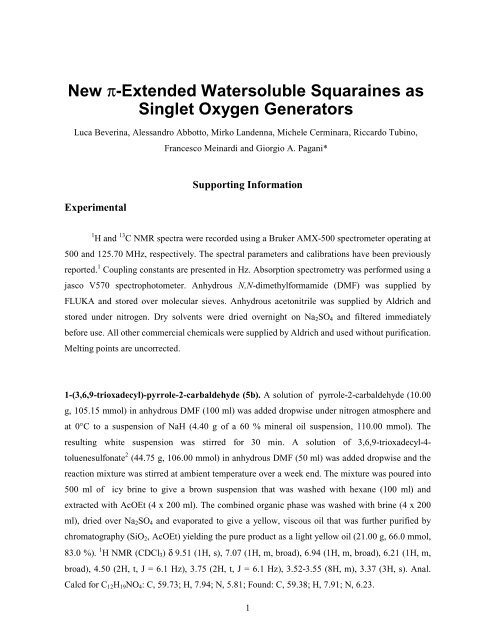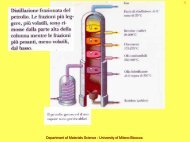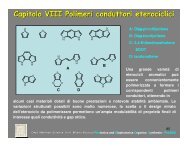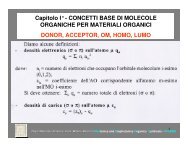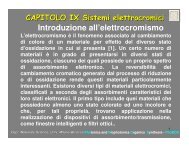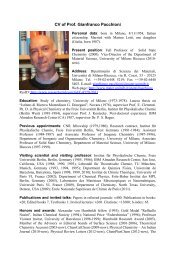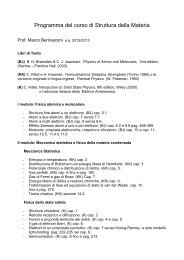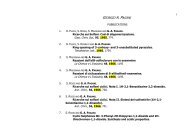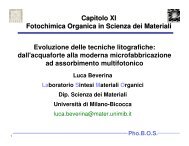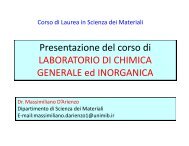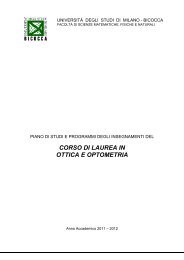New Ï-Extended Watersoluble Squaraines as Singlet Oxygen ...
New Ï-Extended Watersoluble Squaraines as Singlet Oxygen ...
New Ï-Extended Watersoluble Squaraines as Singlet Oxygen ...
You also want an ePaper? Increase the reach of your titles
YUMPU automatically turns print PDFs into web optimized ePapers that Google loves.
<strong>New</strong> π-<strong>Extended</strong> <strong>Watersoluble</strong> <strong>Squaraines</strong> <strong>as</strong><br />
<strong>Singlet</strong> <strong>Oxygen</strong> Generators<br />
Luca Beverina, Alessandro Abbotto, Mirko Landenna, Michele Cerminara, Riccardo Tubino,<br />
Francesco Meinardi and Giorgio A. Pagani*<br />
Experimental<br />
Supporting Information<br />
1 H and 13 C NMR spectra were recorded using a Bruker AMX-500 spectrometer operating at<br />
500 and 125.70 MHz, respectively. The spectral parameters and calibrations have been previously<br />
reported. 1 Coupling constants are presented in Hz. Absorption spectrometry w<strong>as</strong> performed using a<br />
j<strong>as</strong>co V570 spectrophotometer. Anhydrous N,N-dimethylformamide (DMF) w<strong>as</strong> supplied by<br />
FLUKA and stored over molecular sieves. Anhydrous acetonitrile w<strong>as</strong> supplied by Aldrich and<br />
stored under nitrogen. Dry solvents were dried overnight on Na 2 SO 4 and filtered immediately<br />
before use. All other commercial chemicals were supplied by Aldrich and used without purification.<br />
Melting points are uncorrected.<br />
1-(3,6,9-trioxadecyl)-pyrrole-2-carbaldehyde (5b). A solution of pyrrole-2-carbaldehyde (10.00<br />
g, 105.15 mmol) in anhydrous DMF (100 ml) w<strong>as</strong> added dropwise under nitrogen atmosphere and<br />
at 0°C to a suspension of NaH (4.40 g of a 60 % mineral oil suspension, 110.00 mmol). The<br />
resulting white suspension w<strong>as</strong> stirred for 30 min. A solution of 3,6,9-trioxadecyl-4-<br />
toluenesulfonate 2 (44.75 g, 106.00 mmol) in anhydrous DMF (50 ml) w<strong>as</strong> added dropwise and the<br />
reaction mixture w<strong>as</strong> stirred at ambient temperature over a week end. The mixture w<strong>as</strong> poured into<br />
500 ml of icy brine to give a brown suspension that w<strong>as</strong> w<strong>as</strong>hed with hexane (100 ml) and<br />
extracted with AcOEt (4 x 200 ml). The combined organic ph<strong>as</strong>e w<strong>as</strong> w<strong>as</strong>hed with brine (4 x 200<br />
ml), dried over Na 2 SO 4 and evaporated to give a yellow, viscous oil that w<strong>as</strong> further purified by<br />
chromatography (SiO 2 , AcOEt) yielding the pure product <strong>as</strong> a light yellow oil (21.00 g, 66.0 mmol,<br />
83.0 %). 1 H NMR (CDCl 3 ) δ 9.51 (1H, s), 7.07 (1H, m, broad), 6.94 (1H, m, broad), 6.21 (1H, m,<br />
broad), 4.50 (2H, t, J = 6.1 Hz), 3.75 (2H, t, J = 6.1 Hz), 3.52-3.55 (8H, m), 3.37 (3H, s). Anal.<br />
Calcd for C 12 H 19 NO 4 : C, 59.73; H, 7.94; N, 5.81; Found: C, 59.38; H, 7.91; N, 6.23.<br />
1
2-(N,N-diphenylhydrazonomethyl)-1-methyl-pyrrole (6a). A mixture of N,N-diphenylhydrazine<br />
hydrochloride (4.19 g, 19.00 mmol) and N-methylpyrrole-2-carboxaldehyde 5a (2.03 g, 18.62<br />
mmol) w<strong>as</strong> suspended in deg<strong>as</strong>sed THF (80 ml) and refluxed under nitrogen atmosphere for 1h. The<br />
Color turned gradually from yellow to deep green and a dark precipitate w<strong>as</strong> formed. The<br />
suspension w<strong>as</strong> cooled and filtered, the solution w<strong>as</strong> evaporated to give a blue sticky solid that w<strong>as</strong><br />
taken up with a CH 2 Cl 2 and filtered through a pad of florisil. Evaporation of the solvent gave a<br />
waxy off-white solid that w<strong>as</strong> readily air oxidized turning dark and that w<strong>as</strong> used directly without<br />
further purification (3.35 g, 12.17 mmol, 65.3 %). 1 H NMR (DMSO-d 6 ) δ 7.45 (4H, t, J = 7.9 Hz),<br />
7.18 (2H, t, J = 7.3 Hz), 7.14 (1H, s), 7.09 (4H, d, J = 7.2 Hz), 6.87 (1H, t, J = 2.1 Hz), 6.18 (1H,<br />
dd, J = 3.6, 1.52 Hz), 6.00 (2H, t, J = 3.5 Hz), 3.92 (3H, s).<br />
2-(N,N-diphenylhydrazonomethyl)-1-(3,6,9-trioxadecyl)-pyrrole (6b). A mixture of N,Ndiphenylhydrazine<br />
hydrochloride (1.24 g, 5.60 mmol) and aldehyde 5b (1.35 g, 5.60 mmol) w<strong>as</strong><br />
suspended in deg<strong>as</strong>sed THF (50 ml) and refluxed under nitrogen atmosphere for 1h. The color<br />
turned gradually from yellow to black. The suspension w<strong>as</strong> cooled and the solvent evaporated to<br />
give a dark oil that w<strong>as</strong> taken up with a AcOEt and filtered through a pad of Florisil. Evaporation of<br />
the solvent gave the product <strong>as</strong> a brown oil that w<strong>as</strong> used directly without further purification (1.56<br />
g, 3.80 mmol, 68.0 %). 1 H NMR (DMSO-d 6 ) δ 7.44 (4H, t, J = 7.9 Hz), 7.18 (2H, t, J = 7.3 Hz),<br />
7.14 (1H, s), 7.09 (4H, d, J = 7.7 Hz), 6.92 (1H, m, broad), 6.19 (1H, m, broad), 6.02 (2H, t, J = 3.3<br />
Hz), 4.49 (2H, t, J = 6.1 Hz), 3.77 (2H, t, J = 6.1 Hz), 3.52-3.55 (8H, m), 3.23 (3H, s). 13 C (acetoned<br />
6 ) δ 145.9, 132.7, 131.7, 129.9, 128.4, 126.0, 124.2, 115.7, 109.7, 73.7, 72.5, 72.3 (2C), 72.1, 59.8,<br />
50.2.<br />
2-(N,N-dimethylhydrazonomethyl)-1-(3,6,9-trioxadecyl)-1H-pyrrole (6c). A mixture of N,Ndimethylhydrazine<br />
(1.27 g, 21.13 mmol) p-toluenesulphonic acid (3.29 g, 21.13 mmol) and<br />
aldehyde 5b (5.13 g, 21.13 mmol) w<strong>as</strong> suspended in deg<strong>as</strong>sed THF (100 ml) and refluxed under<br />
nitrogen atmosphere for 30 min. A second aliquot of N,N-dimethylhydrazine (1.27 g, 21.13 mmol)<br />
w<strong>as</strong> added and the reflux maintained for an additional 30 min. The solvent w<strong>as</strong> removed and the<br />
residue taken up with AcOEt and purified by filtration through a short silica gel column.<br />
Evaporation of the solvent afforded a yellow-brown viscous oil that w<strong>as</strong> used directly without<br />
further purification (3.90 g, 13.8 mmol, 65.3 %).<br />
2
2-(N-(4-bromophenylhydrazonomethyl)-1-methylpyrrole (6d). A mixture of 4-<br />
bromophenylhydrazine hydrochloride (3.00 g, 13.42 mmol) and 5a (1.47 g, 13.42 mmol) w<strong>as</strong><br />
suspended in deg<strong>as</strong>sed THF (50 ml) and stirred at room temperature for 6 h under nitrogen<br />
atmosphere. The color turns from light yellow to dark blue. The solvent w<strong>as</strong> removed and the black<br />
sticky residue purified by chromatography (SiO 2, CH 2 Cl 2 ) to give the pure compound <strong>as</strong> a yellow<br />
powder (1.02 g, 3.67 mmol, 33 %). 1 H NMR (CDCl 3 ) δ 7.68 (1H, s), 7.34 (2H, d, J = 8.8 Hz), 6.88<br />
(2H, d, J = 8.8 Hz), 6.71 (1H, t, J = 2.2 Hz), 6.34 (1H, dd, J = 3.7, 1.8 Hz), 6.14 (1H, dd, J = 3.6,<br />
2.6), 3.96 (3 H, s).<br />
1-[4-pyridyl]-2-(N-(3,6,9-trioxadecyl)-2-pyrrolyl)ethylene (7a). tBuOK (2.56 g, 22.80 mmol)<br />
w<strong>as</strong> added portionwise under nitrogen atmosphere to a solution of 4-picoline (1.93 g, 20.70 mmol)<br />
and 5b (5.00 g, 20.74 mmol) in anhydrous DMF (20 ml). The resulting red solution w<strong>as</strong> stirred at<br />
80 °C for 1 h and at room temperature overnight. The reaction mixture w<strong>as</strong> poured into 200 ml of<br />
crushed ice to give a yellow suspension that w<strong>as</strong> extracted with AcOEt (3 x 200 ml). The combined<br />
organic ph<strong>as</strong>e w<strong>as</strong> w<strong>as</strong>hed with brine (4 x 200 ml), dried over Na 2 SO 4 and evaporated affording the<br />
product <strong>as</strong> a dark yellow oil that w<strong>as</strong> used directly without further purification in the subsequent<br />
step (5.00 g, 15.80 mmol, 76.3 %). 1 H NMR (DMSO-d 6 ) δ 8.49 (2H, d, J = 5.5 Hz), 7.27 (2H, d, J =<br />
5.5 Hz), 7.24 (1H, d, J = 16.1 Hz), 6.77 (1H, s, broad), 6.73 (1H, d, J = 16.1 Hz), 6.58 (1H, d, J =<br />
3.5 Hz), 6.17 (1H, t, J = 3.2 Hz), 4.16 (2H, t, J = 5.6 Hz), 3.72 (2H, t, J = 5.6 Hz), 3.59-3.53 (6H,<br />
m), 3.47 (2H, m), 3.23 (3H, s).<br />
1-[4-quinolyl]-2-(N-(3,6,9-trioxadecyl)-2-pyrrolyl)ethylene (7b). tBuOK (1.12 g, 10.01 mmol)<br />
w<strong>as</strong> added portionwise under nitrogen atmosphere to a solution of 4-methylquinoline (1.30 g, 9.10<br />
mmol) and 5b ( 2.20 g, 9.12 mmol) in anhydrous DMF (15 ml). The resulting red fluorescent<br />
solution w<strong>as</strong> stirred at 80 °C for 1 h and at room temperature overnight. The reaction mixture w<strong>as</strong><br />
poured into 200 ml of crushed ice to give a red-orange suspension that w<strong>as</strong> extracted with AcOEt (3<br />
x 200 ml). The combined organic ph<strong>as</strong>e w<strong>as</strong> w<strong>as</strong>hed with brine (4 x 200 ml), dried over Na 2 SO 4 and<br />
evaporated affording a red oil that w<strong>as</strong> purified by chromatography (SiO 2 AcOEt) to give the<br />
product <strong>as</strong> an orange oil (1.92 g, 5.50 mmol, 60.0 %). 1 H NMR (CDCl 3 ) δ 8.85 (1H, d, J = 4.7 Hz),<br />
8.21 (1H, d, J = 8.3 Hz), 7.72 (1H, t, J = 8.5 Hz), 7.55 (1H, d, J = 5.1 Hz), 7.57 (1H, d, J = 8.5 Hz),<br />
7.58 (1H, d, J = 15.8 Hz), 7.31 (1H, d, J = 15.8 Hz), 6.83 (1H, dd, J = 2.5, 1.7 Hz), 6.72 (1H, dd,<br />
3
3.8, 1.5 Hz), 6.24 (1H, t, J = 3.5 Hz), 4.22 (2H, t, J = 5.7 Hz), 3.77 (2H, t, J = 5.7 Hz), 3.75-3.35<br />
(8H, m), 3.23 (3H, s).<br />
Preparation of squaraine 1a. Squaric acid (0,510 g, 4.50 mmol) w<strong>as</strong> added <strong>as</strong> a solid to a<br />
refluxing solution of compound 6a (2,600 g, 9.44 mmol) in absolute ethanol (150 ml). The colour<br />
immediately turned deep green. After 1 h at the reflux temperature, the green suspension w<strong>as</strong><br />
cooled at 0°C and the precipitate filtered at reduced pressure. The crude product w<strong>as</strong> w<strong>as</strong>hed with<br />
hot EtOH (80 ml) and crystallized from AcOH to give the pure compound <strong>as</strong> a powder with golden<br />
luster (0,800 g, 1.27 mmol, 28.3 %). M.p. > 300 °C (dec.) 1 H NMR (CD 2 Cl 2 ) δ 7.66 (2H, d, J = 4.4<br />
Hz), 7.41 (8H, t, J = 7.7 Hz), 7.22 (4H, t, J = 7.3 Hz), 7.15 (8H, d, J = 7.9 Hz), 7.07 (2H, s), 6.69<br />
(2H, dd, J = 4.5 Hz), 4.26 (6H, s); 13 C (CDCl 3 ) 168.3, 168.2, 143.8, 142.4, 131.9, 130.1, 125.8,<br />
125.0, 123.8, 122.4, 117.1, 36.0. Anal. Calcd for C 40 H 32 N 6 O 2 : C, 76.41; H, 5.13; N, 13.37; Calcd<br />
for C 40 H 32 N 6 O 2 x ½ H 2 O: C, 75.33; H, 5.22; N, 13.18; Found: C, 75.33; H, 5.19; N, 12.88.<br />
Preparation of squaraine 1b. A suspension of squaric acid (0.140 g, 1.22 mmol) and hydrazone<br />
6b (1.000 g, 2.45 mmol) in a 1:1 BuOH/toluene mixture (120 ml) w<strong>as</strong> refluxed in a Dean-Stark<br />
apparatus for 3 h. The solvent w<strong>as</strong> removed and the deep green oily residue w<strong>as</strong> w<strong>as</strong>hed with water<br />
(50 ml) and dissolved in boiling isopropanol (60 ml). The solvent evaporation afforded a golden,<br />
shiny solid that w<strong>as</strong> taken up with Et 2 O and filtered at reduced pressure. (0.530 g, 0.59 mmol, 48.6<br />
%). M.p. [EtOH] 127-130 °C. 1 H NMR (DMSO-d 6 ) δ 7.62 (2H, d, J = 4.6 Hz), 7.52 (8H, t, J = 7.8<br />
Hz), 7.31 (4H, t, J = 7.4 Hz), 7.26 (2H, s), 7.23 (8H, d, J = 7.8 Hz), 7.06 (2H, d, J = 4.6 Hz), 4.79<br />
(4H, t, J = 4.8 Hz), 3.61 (4H, t, J = 5.2 Hz), 3.43-3.31 (16H, m), 3.15 (6H, s). 13 C (DMSO-d 6 ) 166.8,<br />
166.7, 144.5, 141.9, 130.1, 130.0, 125.6, 125.0, 122.6, 122.1, 116.0, 71.1, 70.5, 69.8, 69.7, 69.5,<br />
57.9, 46.7. Anal. Calcd for C 52 H 56 N 6 O 8 : C, 69.94; H, 6.32; N, 9.41; Found: C, 70.18; H, 6.45; N,<br />
9.32.<br />
Preparation of squaraine 1c. A suspension of squaric acid (0.370 g, 3.25 mmol) and hydrazone 6c<br />
(1.850 g, 6.54 mmol) in a 1:1 BuOH/toluene mixture (120 ml) w<strong>as</strong> refluxed in a Dean-Stark<br />
apparatus for 3 h. The solvent w<strong>as</strong> removed and the deep green oily residue w<strong>as</strong> taken up with<br />
deionised water (100 ml) and extracted with AcOEt (3 x 150 ml). The combined organic ph<strong>as</strong>e w<strong>as</strong><br />
dried over Na 2 SO 4 and evaporated to give a dark oil. Addition of 10 ml of toluene started the<br />
4
crystallization of a golden solid that w<strong>as</strong> filtered and further crystallized from EtOH (0.420 g, 0.65<br />
mmol, 20.0 %). M.p. [EtOH] 121-122 °C. 1 H NMR (DMSO-d 6 ) δ 7.52 (2H, d, J = 4.5 Hz), 7.26<br />
(2H, s), 6.75 (2H, d, J = 4.5 Hz), 4.94 (4H, t, J = 5.0 Hz), 3.67 (4H, t, J = 5.2 Hz), 3.47-3.32 (16H,<br />
m), 3.19 (6H, s), 3.11 (12H, s). 13 C (DMSO-d 6 ) 163.4, 157.9, 146.0, 128.9, 122.2, 120.1, 113.5,<br />
71.1, 70.7, 70.0, 69.7, 69.5, 57.9, 46.1, 42.4. Anal. Calcd for C 32 H 48 N 6 O 8 : C, 59.61; H, 7.50; N,<br />
13.03; Found: C, 59.76; H, 7.59; N, 12.99.<br />
Preparation of squaraine 1d. A suspension of hydrazone 6d (0.500 g, 1.80 mmol) and squaric<br />
acid (0.103 g, 0.90 mmol) in absolute ethanol (80 ml) w<strong>as</strong> refluxed for 3 h. Upon cooling a dark<br />
green precipitate w<strong>as</strong> formed and filtered at reduced pressure. Crystallization form AcOH gave the<br />
pure compound <strong>as</strong> a green powder (0.306 g, 0.48 mmol, 53.6 %). M.p. > 300 °C (dec.). 1 H NMR<br />
(DMSO-d 6 ) δ 7.93 (2H, s), 7.61 (2H, d, J = 4.6 Hz), 7.44 (4H, d, J = 8.8 Hz), 7.09 (4H, d, J = 8.8<br />
Hz), 7.0 (2H, d, J = 4.6 Hz), 4.30 (6H, s). The 13 C NMR could not be recorded because of<br />
insufficient solubility. Anal. Calcd for C 28 H 22 Br 2 N 6 O 2 : C, 53.02; H, 3.50; N, 13.25; Found: C,<br />
53.54; H, 3.79; N, 13.23.<br />
Preparation of squaraine 2a. A suspension of squaric acid (0.230 g, 2.01 mmol), pyridine (0.320<br />
g, 4.03 mmol) and chromophore 7a (1.400 g, 4.42 mmol) in a 1:1 toluene/BuOH mixture (40 ml)<br />
w<strong>as</strong> refluxed in a Dean-Stark apparatus for 1.5 h. The resulting deep green solution w<strong>as</strong> chilled at<br />
0°C overnight. A golden precipitate w<strong>as</strong> formed and filtered at reduced pressure. Crystallization<br />
from EtOH/H 2 O gave the pure compound <strong>as</strong> a golden green powder (0.600 mg, 0.84 mmol, 20 %).<br />
M.p. 172-173 °C. 1 H NMR (DMSO-d 6 ) δ 8.72 (4H, d, J = 6.4 Hz), 7.90 (4H, d, J = 6.4 Hz), 7.87<br />
(2H, d, J = 16.1 Hz), 7.74 (2H, d, J = 4.6 Hz), 7.60 (2H, d, J = 16.1 Hz), 7.33 (2H, d, J = 4.7 Hz),<br />
4.60 (4H, t, J = 4.4 Hz), 3.70 (4H, t, J = 4.7 Hz), 3.44 (4H, m), 3.34 (4 H, m), 3.29 (4H, m), 3.23<br />
(4H, m), 3.12 (6 H, s); 13 C (DMSO-d 6 ) 193.2, 170.4, 147.5, 146.7, 146.4, 130.7, 130.6, 123.5,123.4,<br />
122.1, 116.0, 71.0, 70.9, 70.1, 70.0, 69.5, 57.8, 46.3. Anal. Calcd for C 40 H 46 N 4 O 8 : C, 67.59; H,<br />
6.52; N, 7.88; Calcd for C 40 H 46 N 4 O 8 x 2/3 H 2 O: C, 65.11; H, 6.69; N, 7.59; Found: C, 65.26; H,<br />
6.80; N, 8.13.<br />
Preparation of squaraine 2b. A suspension of squaric acid (0.078 g, 0.68 mmol), pyridine (0.108<br />
g, 1.36 mmol) and chromophore 7b (0.500 g, 1.36 mmol) in a 1:1 toluene/BuOH mixture (40 ml)<br />
5
w<strong>as</strong> refluxed in a Dean-Stark apparatus for 4 h. The resulting deep green solution w<strong>as</strong> chilled at 0°C<br />
overnight and the formed golden precipitate collected by suction filtration. Crystallization from<br />
EtOH gave the pure compound <strong>as</strong> a golden green powder (0.100 mg, 0.12 mmol, 18.1 %). M.p.<br />
169-170 °C. 1 H NMR (DMSO-d 6 ) δ 8.94 (2H, J = 4.7 Hz), 8.57 (2H, d, J = 8.4 Hz), 8.34 (2H, d, J =<br />
15.8 Hz), 8.06 (2H, d, J = 8.3 Hz), 7.98 (2H, d, J = 4.7 Hz), 7.81 (2H, d, J = 15.8 Hz), 7.79 (2H, t, J<br />
= 8.3 Hz), 7.77 (2H, d, J = 4.7 Hz), 7.69 (2H, t, J = 7.9 Hz), 7.62 (2H, d, J = 4.6 Hz), 5.12 (4H, t, J =<br />
4.8 Hz), 3.74 (4H, t, J = 4.8 Hz), 3.47 (4H, m), 3.35 (4H, m), 3.27 (4H, m), 3.16 (4H, m), 3.05 (6H,<br />
s). Anal. Calcd for C 48 H 50 N 4 O 8 : C, 71.09; H, 6.21; N, 6.91; Found: C, 70.64; H, 6.19; N, 6.83.<br />
Preparation of squaraine 3. A suspension of 2-methylindolizine 3 (1.680 g, 12.81 mmol) and<br />
squaric acid (0.730 g, 6.40 mmol) in a 1:1 mixture of BuOH/toluene (75 ml) w<strong>as</strong> refluxed for 2h in<br />
a Dean-Stark apparatus. Upon cooling a dark green precipitate w<strong>as</strong> formed and collected by suction<br />
filtration. Crystallization from CH 3 CN afforded the pure compound <strong>as</strong> a green powder (0.101 g,<br />
0.25 mmol, 26 %). M.p. > 300 °C (dec). 1 H NMR (CD 2 Cl 2 ) δ 10.27 (2H, d, J = 6.9 Hz), 7.26 (2H,<br />
d, J = 8.5 Hz), 7.11 (2H, t, J = 8.0 Hz), 6.81 (2H, t, J = 6.6 Hz), 6.46 (2H, s), 2.76 (6H, s); 13 C<br />
(CDCl 3 ) 176.3, 166.5,143.0, 139.2, 135.0, 127.5, 122.5, 117.7, 113.8, 111.9, 15.4. Anal. Calcd for<br />
C 22 H 16 N 2 O 2 : C, 77.63; H, 4.74; N, 8.23; Anal. Calcd for C 22 H 16 N 2 O 2 x ¼ H 2 O: C, 76.62; H, 4.82;<br />
N, 8.12; Found: C, 76.90; H, 4.72; N, 7.63.<br />
N<br />
O<br />
O<br />
H 3 C<br />
N<br />
CH 3<br />
3<br />
Squaraine 3 structure w<strong>as</strong> <strong>as</strong>signed on the b<strong>as</strong>is of its 1 H NMR spectrum. 2-methylindolizine 1 H<br />
NMR spectrum (DMSO-d 6 ) in fact shows two singlets in the high field aromatic region at 7.31 ppm<br />
and 6.18 ppm corresponding respectively to the H 3 and H 1 protons. Squaraine 3 1 H NMR spectrum<br />
(CD 2 Cl 2 ) only displays one singlet at 6.46 ppm. According to the electron withdrawing nature of the<br />
squaraine core, and so with the expected low field shift of the indolizine signals in the squaraine,<br />
the 6.46 ppm singlet can be unambiguously <strong>as</strong>signed to the position 1 of a 3 substituted 2-<br />
methylindolizine, hence the <strong>as</strong>signed condensation regiochemistry.<br />
Indolizine numbering:<br />
6
7<br />
6<br />
8<br />
N<br />
4<br />
5<br />
1<br />
3<br />
2<br />
DPBF degradations.<br />
ABS<br />
1,2<br />
1,0<br />
0,8<br />
0,6<br />
0,4<br />
0,2<br />
0 min<br />
3 min<br />
6 min<br />
9 min<br />
12 min<br />
15 min<br />
20 min<br />
25 min<br />
30 min<br />
35 min<br />
40 min<br />
46 min<br />
50 min<br />
55 min<br />
60 min<br />
0,0<br />
300 400 500 600 700 800 900<br />
Wavelength (nm)<br />
Figure S1. Time evolution of the UV-Vis spectrum of a DPBF (50 µM) and 2b (5 µM) CH 2 Cl 2<br />
solution.<br />
7
1,2<br />
1,0<br />
0,8<br />
415<br />
727,5<br />
0 min<br />
15 min<br />
25 min<br />
40 min<br />
55 min<br />
70 min<br />
85 min<br />
100 min<br />
ABS<br />
0,6<br />
0,4<br />
0,2<br />
400 500 600 700 800<br />
Wavelength [nm]<br />
Figure S2. Time evolution of the UV-Vis spectrum of a DPBF (50 µM) and 1b (5 µM) CH 2 Cl 2<br />
solution.<br />
ABS<br />
1,0<br />
0,8<br />
0,6<br />
0 min<br />
15 min<br />
30 min<br />
45 min<br />
60 min<br />
75 min<br />
90 min<br />
120 min<br />
150 min<br />
180 min<br />
210 min<br />
0,4<br />
0,2<br />
0,0<br />
400 500 600 700 800<br />
Wavelength [nm]<br />
Figure S3. Time evolution of the UV-Vis spectrum of a DPBF (50 µM) and 1c (5 µM) CH 2 Cl 2<br />
solution.<br />
8
ABS<br />
1,2<br />
1,0<br />
0,8<br />
0,6<br />
DPBF<br />
1d<br />
0 min<br />
3 min<br />
6 min<br />
9 min<br />
12 min<br />
15 min<br />
20 min<br />
25 min<br />
30 min<br />
35 min<br />
40 min<br />
45 min<br />
50 min<br />
55 min<br />
60 min<br />
0,4<br />
0,2<br />
0,0<br />
300 400 500 600 700 800 900<br />
Wavelength (nm)<br />
Figure S4. Time evolution of the UV-Vis spectrum of a DPBF (50 µM) and 1d (5 µM) CH 2 Cl 2<br />
solution.<br />
ABS<br />
1,2<br />
1,0<br />
0,8<br />
0,6<br />
0,4<br />
0,2<br />
00 min<br />
03 min<br />
06 min<br />
09 min<br />
12 min<br />
15 min<br />
20 min<br />
25 min<br />
30 min<br />
35 min<br />
40 min<br />
45 min<br />
50 min<br />
55 min<br />
60 min<br />
0,0<br />
300 400 500 600 700 800 900<br />
Wavelength (nm)<br />
9
Figure S5. Time evolution of the UV-Vis spectrum of a DPBF (50 µM) and 2a (5 µM) CH 2 Cl 2<br />
solution.<br />
ABS<br />
1,0<br />
0,8<br />
0,6<br />
0,4<br />
0,2<br />
00 min<br />
03 min<br />
06 min<br />
09 min<br />
12 min<br />
15 min<br />
20 min<br />
25 min<br />
30 min<br />
35 min<br />
40 min<br />
45 min<br />
50 min<br />
55 min<br />
0,0<br />
300 400 500 600 700 800<br />
Wavelength (nm)<br />
Figure S6. Time evolution of the UV-Vis spectrum of a DPBF (50 µM) and 3 (5 µM) CH 2 Cl 2<br />
solution.<br />
10
ABS<br />
1,2<br />
1,0<br />
0,8<br />
0,6<br />
0 min 14 min<br />
1 min 16 min<br />
2 min 18 min<br />
3 min 20 min<br />
4 min 26 min<br />
5 min 30 min<br />
6 min 34 min<br />
8 min 38 min<br />
10 min 42 min<br />
12 min<br />
0,4<br />
0,2<br />
0,0<br />
350 400 450 500<br />
Wavelenght [nm]<br />
Figure S7. Time evolution of the UV-Vis spectrum of a DPBF (50 µM) and TPP (5 µM) CH 2 Cl 2<br />
solution. The TPP spectrum h<strong>as</strong> been subtracted from all the spectra.<br />
References<br />
1 Abbotto, A.; Alanzo, V.; Bradamante, S.; Pagani, G. A. J. Chem. Soc., Perkin Trans. 2 1991, 481.<br />
2 Lottner, C.; Bart, K.; Bernhardt, G.; Brunner, H. J. Med. Chem. 2002, 45, 2079<br />
3 Chichibabin, A. E. Chem. Ber. 1927, 60, 1607.<br />
11


